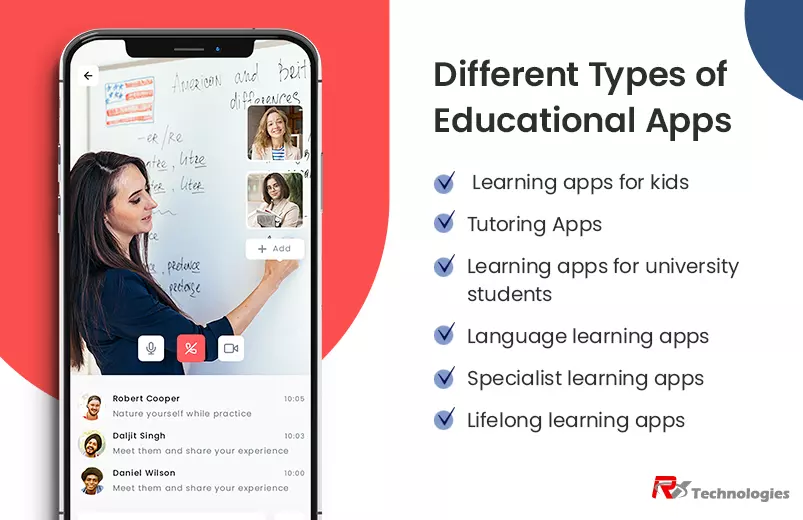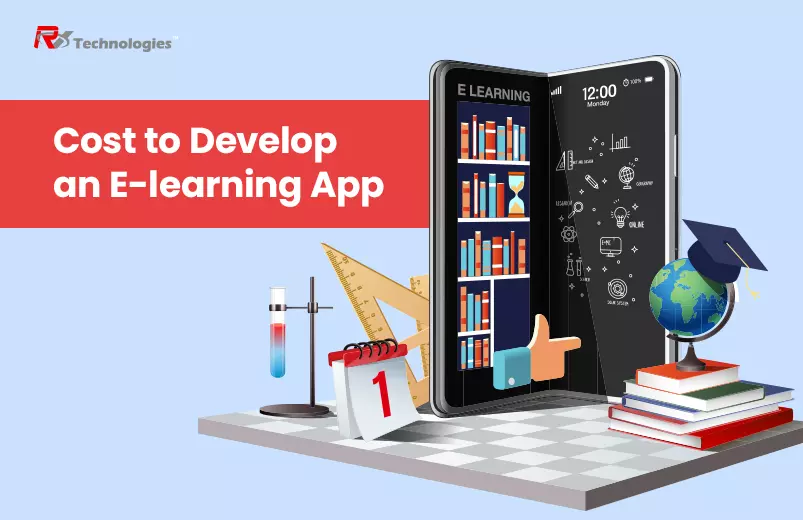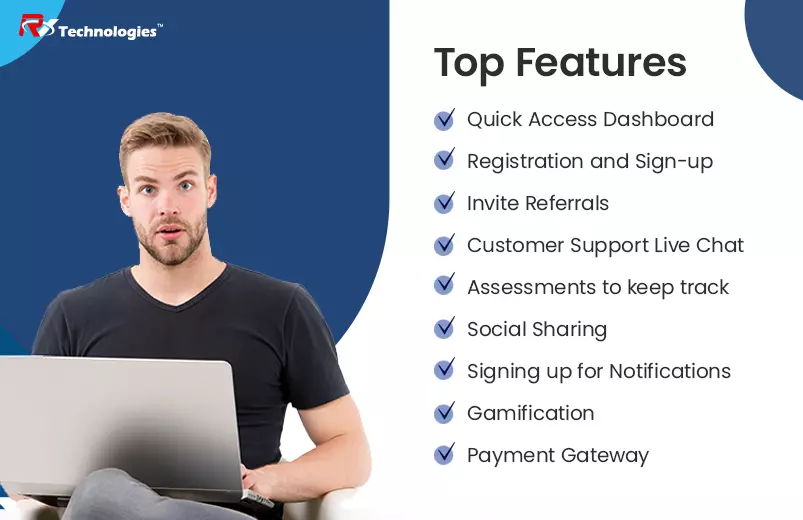The global ed-tech market was valued at USD 254.80 billion in 2021 and is expected to reach USD 605.40 billion by 2027, growing at a CAGR of 15.52% during this time, according to the EdTech Market – Global Outlook & Forecast 2022-2027.
This signifies the gigantic digital revolution that the edtech platform development segment is in the midst of.
Accelerated further by the Covid-19 pandemic, learners across age groups and geographies are seeking to learn online to gain knowledge, clock in some practice, and sharpen their existing skills or learn a new skill.
According to UNESCO, in March 2020, over 1.2 billion students in 186 countries were affected by school closures.
This brought unprecedented growth in distance learning and e-learning.
Professionals who began working remotely, as well as the ones who lost their jobs during this time, realized the importance of following their passions and making time for something they always wanted to learn but never really got around to.
Besides, they also understood that to remain competitive and relevant in the job market, they would need to engage in e-learning and up their game.
Also, Read | Guide to Create Job Portal Website in 2023
The market seems ripe for taking the plunge.
To enter the edtech platform segment, one would need to define their target audience and what they would like to educate the target audience about on their edtech platform.
You would also need to develop all the required training content and conceptualize the learning model to be followed.
However, all this would rest on one very critical asset – the edtech platform that the users would be using.
What features should developers consider building in their EdTech app?
A good edtech platform should be functional, easy to use, quick, responsive, and smooth.
Some of the top features that need to be incorporated during elearning app development are:
1. Quick Access Dashboard
The edtech mobile app should offer a dashboard that is not just aesthetic and welcoming but also gives users access to all important features and functions from the dashboard itself. This is where all the shortcuts would be.
2. Registration and Sign-up
Users must be able to sign in and create their account on the edtech platform.
They should be able to provide their email ID and phone number, which can be used to verify the user’s identity as well as to communicate with them during their learning journey.
Registered users would need to have a complete user profile on the app containing all the details they feel comfortable sharing.
3. Invite Referrals
Users should be able to invite friends, colleagues, family members, etc.
For this, the users themselves need to be having a good learning experience on the edtech mobile app and be getting a small incentive for inviting another user to join the app.
4. Customer Support Live Chat
Users should be able to reach out to the customer support team of the edtech platform immediately for resolving any query they might have.
A chatbot could be programmed for the chat with an option to connect with a live rep or request a callback if more help is needed.
5. Assessments to keep track of progress
The edtech app developer company would have to incorporate session-end assessments as well as program-end assessments to keep track of user progress and map their learning during their time engaging with the e learning platform.
6. Social Sharing
With the immense popularity of social media platforms, there is a need among users to share their learning journey, milestones, and achievements on social media.
Edtech app developers would need to incorporate social sharing abilities for users to let them share their achievements online.
7. Signing up for Notifications
The e learning platform should offer users an option to sign-up for notifications about new course offerings, upcoming sessions, assessment and practice reminders, leaderboard positions, etc.
Users should be able to choose what notifications they want and in what form.
8. Gamification
This is a buzzing new feature for edtech platform adding more thrill to the learning journeys of the users, making things more competitive and exciting.
Gamification features when coded into the learning paths would encourage the audiences to engage more with the app.
9. Payment Gateway
Developers would need to build a payment gateway into the edtech platform they are developing to enable users to pay for the course they choose to enroll in from the app itself.
The payment gateway should also be able to take discount codes to accommodate promotions.
These are some of the top features that need to be incorporated when engaging in education mobile app development.
Bonus | How much does it cost to build a payment app like venmo
What are the different types of EdTech apps that can be developed?

Here are the different types of educational apps that can be developed:
- Learning apps for kids, such as YouTube Kids, WhiteHat Jr.
- Tutoring Apps such as Byjus, Khan Academy, Unacademy
- Learning apps for university students like eDX.
- Language learning apps like Busu, Duolingo italki
- Specialist elearning apps like Coursera, Allison
- Lifelong learning apps like Udemy, UpGrad
What is the tech stack needed for EdTech app development?
To develop a world-class edtech platform, you would need the below tech stack.
For the Android App
- Kotlin for programming
- OkHttp 3 for networking
For the iOS App
- Swift for programming
- Alamofire for networking
For the Hybrid(Cross Platform) Apps
- Flutter or React Native
For back-end development
Laravel
Node.js for programming
- Express 4 for the framework
- MySQL for database management
- Swagger for the API
Other required tools
- AWS for cloud computing
- Amazon SES and Amazon SNS for sign-up functions
- Elastic Email for the email functions
- Elastic Search for the search function
- Braintree for the payment gateway
- FCM for the push notification features
- Amazon S3 for cloud storage
You can also use other cloud storage platforms for your edtech app development project based on your requirements and budget.
AWS is generally regarded as the most cost-effective, secure, and reliable cloud platform, with the highest market share globally.
However, you can choose any platform that fits your needs.
Besides, you can also choose any alternatives to the above-mentioned tools and programming languages that fit your e-learning app development requirement the best.
Also, Read | Mistakes to avoid while creating edtech startup
What team members are needed for EdTech app development?

To develop a world-class edtech platform, you would need the following individuals in your team:
- Business analyst
- Project manager
- UI/UX designer
- Android and/or iOS developers, depending on the platform you choose
- Back-end and front-end developers
- QA professionals
These team members could be hired locally, to work in-house, full-time, or on contract to build this app.
Or, the project could be outsourced to affordable destinations and competent professionals.
Who would work on the project remotely and deliver the edtech platform at affordable rates, with no investment needed on office spaces, purchasing hardware and software, hiring and onboarding new team members, etc?
What is the cost of edtech platform development?

The cost of ed-tech app development would depend on a range of factors including how complex is the elearning platform you are developing,
Q. Where is your development team based,
Q. What are the different tools and technologies you are using, etc?
Let us take a brief look at how two of these factors would determine the costs for educational app development companies.
Edtech App Complexity
The complexity of the edtech app stands for the difficulty of business logic –
Q. How many features do you plan to offer,
Q. How many roles your app has built into it,
Q. How many tools and platforms are integrated into the app,
Q. How complex is the infrastructure, etc?
The more complex the edtech platform, the more advanced the design it calls for, the more research the development team needs to put in, the more planning is required, and the more time and resources it will likely call for.
If we were to take into account some rough back-of-the-envelope calculations on edtech app development costs based purely on complexity, all other factors remaining the same, it could work out to something in the below range:
| App Complexity | Approximate Cost | |
| Simple app, low complexity | $25,000 to $30,000 | |
| Medium complexity app | $50,000 to $60,000 | |
| Elaborate app with high complexity | $75,000 to $90,000 | |
App Development Team Location
Here are the average rates for developers across territories along with their average reliability observations
| Country | Challenges | Advantages | Rates |
| Poland, Romania, Hungary, Austria | The difference in the languages spoken, time zone differences, expensive | Reliable and professional | $30-$65 per hour |
| Mexico, Peru, Brazil, Argentina | The difference in the languages spoken, average reliability, expensive | Time zone in line with the US, upcoming markets | $35-$70 per hour |
| Morocco, Kenya, Nigeria, South Africa | Low reliability, the difference in time zones, language, and cultural differences | Cost efficiency | $25-$45 per hour |
| India | The difference in time zones, cultural differences | Highly efficient and reliable, cheaper, highly reliable | $20-$45 per hour |
As you can see, outsourcing edtech app development to India can be highly beneficial.
The developer rates in India are comparatively much lower while offering a lot of skilled talent available to hire at very competitive rates.
Indian developers are known all over the world to be highly skilled, efficient, and professional, and are highly sought-after by the top IT companies everywhere.
If required, background checks can be run and references be verified for the developers you decide to hire as well.
India is a known market for outsourcing and development teams in India are well-versed in working with offshore clientele.
The quality of IT education in the country produces highly skilled developers and IT professionals, who can be hired at much cheaper rates than in other countries of the world as the currency exchange rate works out in favor of most companies.
A junior-level developer in India could cost you about $19-20 per hour while a senior-level developer in India could be hired at $40-45 per hour.
India makes sense for outsourcing your edtech app development project.
In Conclusion
Elearning mobile apps are the third most frequently installed applications on mobile phones globally.
The segment is set to grow exponentially in the coming years, fueled by advancing technologies and a need to keep one’s skills sharp and stay ahead of the curve.
The world has seen huge success stories in the ed-tech segment – from Coursera to Byjus, from Duolingo to eDX.
Bigger the demand for edtech apps, the bigger the demand for edtech app development and educational app development companies.
Edtech app development offers developers a chance to showcase their talent and use their skills to help countless individuals across the globe to learn new skills and build their careers.





 Updated: April 26, 2022
Updated: April 26, 2022 







